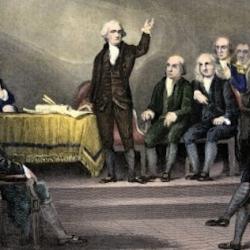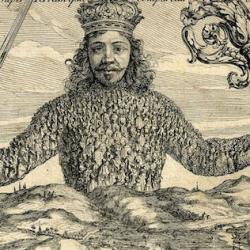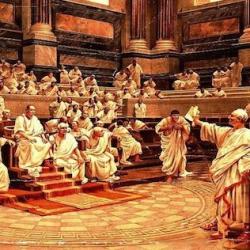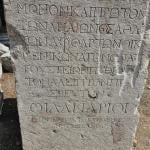In an essay on the “limits of the state,” Timothy Mitchell tests several theories of the state and finds them wanting. Shortly after World War II, American political scientists generally abandoned the concept of the state “as a concept too vague and too narrow to be the basis of a general science of politics.” In place of “state,” political scientists spoke of “political systems.” The change of vocabulary didn’t solve the theoretical problems and, after the late 1970s, theory swung the other way, reintroducing the notion of the “state” (77).
At the heart of this oscillation was the question of how to distinguish “state” from other realities of political communities, specifically “society.” Mitchell argues that the elusiveness of this distinction isn’t a problem to solve but a clue to the character of the state itself. He proposes to begin “with the assumption that the elusiveness of the state-society boundary needs to be taken seriously, not as a problem of conceptual precision but as a clue to the nature of the phenomenon” (78).
Drawing on Foucault’s notion of “disciplines,” he argues that the state is a “structural effect.” Foucault’s work enables political theorists to “move beyond the image of power as essentially a system of authoritative commands or policies backed by force.” Disciplinary power works “from within” and “at the level of detail.” A negative power that curbs behavior becomes instead a productive form of power: “Disciplines work within local domains and institutions, entering into particular social processes, breaking them down into separate functions, rearranging the parts, increasing their efficiency and precision, and reassembling them into more productive and powerful combinations.” Such disciplinary methods produce “the organized power of armies, schools and factories, and other distinctive institutions of modern nation states.” At the same time, disciples produce certain types of people, the kinds of modern people who are at home in the institutions of modernity—“the modern individual, constructed as an isolated, disciplined, receptive, and industrious political subject” (93).
One of the implications of this model is that resistance itself comes from within the disciplinary matrix of the modern state. Resistance is no more “outside” than is state power: “Political subjects and their modes of resistance are formed as much within the organizational terrain we call the state, rather than in some wholly exterior social space” (93). This is an insightful comment, but it assumes too much homogeneity in modern nation-states. Pervasive as state disciplines may be, there are sub-communities that form different sorts of people through different regimes of discipline. Pervasive as the state may be, it isn’t all-pervasive.
Moving beyond Foucault, Mitchell argues that the disciplined institutions of the modern state take on an apparent objectivity of their own, appear in the “form of external structures.” Pre-modern armies “looked like amorphous gatherings of idle and inactive men,” at least from the perspective of modern military leaders, who created armies that appeared “two dimensional,” consisting of “individual soldiers” on the one hand and a military “machine” on the other” (93).
Mitchell argues that these are not actually two things; the “apparatus has no independent existence” but “is an effect produced by the organized partitioning of space, the regular distribution of bodies, exact timing, the coordination of movement, the combining of elements, and endless repetition” (93–4). The new army had nothing “except this distributing, arranging and moving,” yet “the order and precision of such processes created the effect of an apparatus apart from the men themselves, whose structure orders, contains, and controls them” (94). What is really “a complex of social practices” appears as “a binary order” of individuals within an “inert structure that somehow stands apart from individuals, precedes them, and contains and gives a framework for their lives” (94).
Mitchell suggests that the “state” as a whole can be analyzed in a similar way, as a “metaphysical effect of practices that make such structures appear to exist” (94). He illustrates with the concept of a national frontier or border: “By establishing a territorial boundary and exercising absolute control over movement across it, state practices define and help constitute a national entity. Setting up and policing a frontier involves a variety of fairly modern social practices—continuous barbed-wire fencing [or a big beautiful wall!], passports, immigration laws, inspections, currency control and so on. These mundane arrangements, most of them unknown two hundred or even one hundred years ago, help manufacture an almost transcendental entity, the nation state. This entity comes to seem something much more than the sum of the everyday activities that constitute it, appearing as a structure containing and giving order and meaning to people’s lives” (94).
Mitchell isn’t saying that the state is an ideological construct or unreal. Rather, his argument rests on the effort to put a question mark over the “distinction between conceptual and material, between abstract and real” (95). The distinction is the source of the oscillation of political theory during the twentieth century.
On this account, the line between “state” and “society” isn’t a line between two entities. The appearance of a distinction between the two is an aspect of the structural effect of the state, the appearance of a state that is something more than the sum of its constituting people and practices: “the state should be addressed as an effect of detailed processes of spatial organization, temporal specification, and supervision and surveillance, which create the appearance of a world fundamentally divided into state and society” (95).
Two sets of questions to Mitchell’s stimulating analysis. First, a historical question, about the category of “modern”: Is it true that premodern societies lack the disciplinary mechanisms that would create this structural effect? Or is it instead that premodern societies simply deployed a different array of practices? Second, a historical question of Schmittian inspiration: Mitchell says virtually nothing about theological aspects of the problem. Is “state,” like “sovereignty,” a theological concept evacuated of theological content?
Also, a theoretic question or set of questions: Suppose Mitchell is right. Is it misleading to speak in terms of “appearance” and “effect”? Isn’t the “appearance” of a state in fact a state? We can raise this question in strong or weak forms. In the weak form, the question is, Is the fact that people believe there is a state “out there” itself a political fact? The stronger form is: Is the effect of these practices actually a something that in fact is greater than the sum of parts? Mitchell seems to suggest as much when he calls the state a “powerful, metaphysical effect” but earlier in the same sentence he denies that the state is an “actual structure” (94). The ontological status of these effects is left unclear.
We can make the question more specific by focusing on Mitchell’s example of borders: The Rio Grande River, say, is a natural phenomenon, but it becomes a political boundary because of the various practices that Mitchell identifies. But, given those practices, does the river actually become a political boundary? And, since boundaries are among the features of “states,” is the construction of the river as a political boundary in fact one of the building-blocks of the state? Are we dealing here with what John Searle identifies as “the construction of social reality”—with Searle’s implication that constructed social reality is the only kind there is?
And, finally, a theological question: Paul can speak of the church as a body. That is, isn’t not simply a collection of individuals engaged in various practices and formed by various differences. For Paul, there’s a reality “above and beyond” the individual members. It doesn’t stand “over-against” them, since the body exists only as it has members. But it is not merely a structural effect of practices and disciplines. Or, so it seems. Now: Is this a unique feature of the church, or a clue to the reality of all human communities? Do political communities of all sorts form political bodies?
(Mitchell, “The Limits of the State: Beyond Statist Approaches and Their Critics,” American Political Science Review 85:1 [1991]: 77–96).











